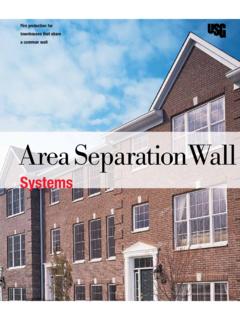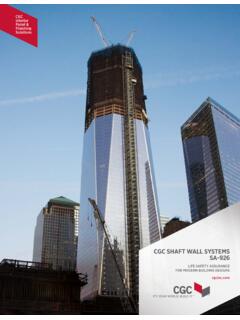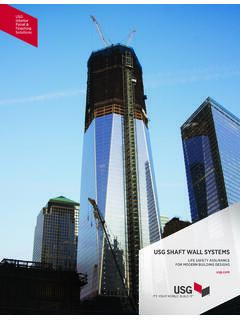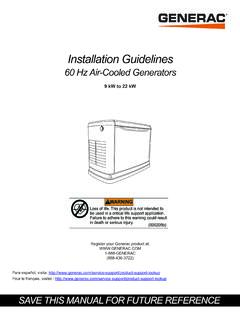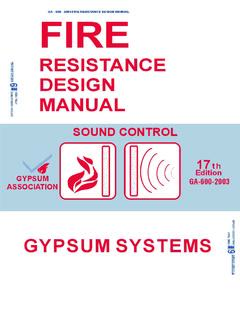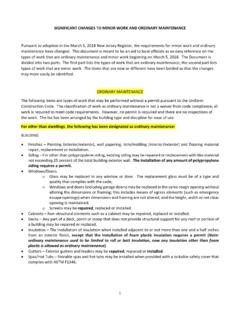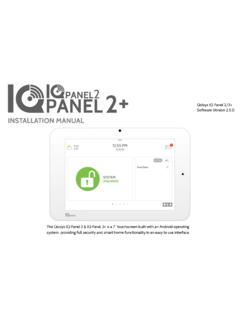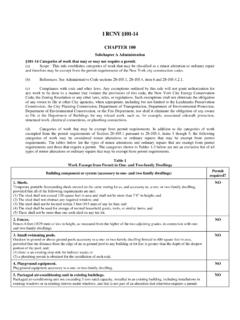Transcription of Guideline on Through Penetration Firestopping
1 Guideline ON. Through - Penetration . Firestopping . SECOND EDITION AUGUST 2007. SHEET METAL AND AIR CONDITIONING CONTRACTORS'. NATIONAL ASSOCIATION, INC. 4201 Lafayette Center Drive Chantilly, VA 20151-1209. Guideline ON Through - Penetration . Firestopping . Copyright SMACNA 2007. All Rights Reserved by SHEET METAL AND AIR CONDITIONING CONTRACTORS'. NATIONAL ASSOCIATION, INC. 4201 Lafayette Center Drive Chantilly, VA 20151-1209. Printed in the FIRST EDITION NOVEMBER 1996. SECOND EDITION AUGUST 2007. Except as allowed in the Notice to Users and in certain licensing contracts, no part of this book may be reproduced, stored in a retrievable system , or transmitted, in any form or by any means, electronic, mechanical, photocopying, recording, or otherwise, without the prior written permission of the publisher. FOREWORD. This technical guide was prepared in response to increasing concerns over the requirements for Through - Penetration Firestopping as mandated by codes, specified by system designers, and required by code officials and/or other authorities having jurisdiction.
2 The language in the model codes, the definitions used, and the expectations of local code authorities varies widely among the model codes and has caused confusion in the building construction industry. Contractors are often forced to bear the brunt of inadequate or confusing specifications, misunderstandings of code requirements, and lack of adequate plan review prior to construction. This guide contains descriptions, illustrations, definitions, recommendations on industry practices, designations of responsibility, references to other documents and guidance on plan and specification requirements. It is intended to be a generic educational tool for use by all parties to the construction process. Firestopping Guideline Second Edition iii FIRE AND SMOKE CONTROL COMMITTEE. Phillip E. Gillespie, Chairman Peter E. O'Leary Brad Snodgrass, Inc. Harrington Bros., Inc. Indianapolis, IN Stoughton, MA.
3 Brad Mattes John Talbot Imperial Damper and Louver Co., Inc. Dynamic Systems Bronx, NY Austin, TX. Roy K. Neese Bob Wasilewski Heating & Plumbing Engineers, Inc. SMACNA, Inc. Colorado Springs, CO Chantilly, VA. iv Firestopping Guideline Second Edition NOTICE TO USERS. Any information contained in this publication was developed using reliable engineering principles and consultation with, and information obtained from, manufacturers, users, and others having specialized experience. It is subject to revision as further experience and investigation may show is necessary or desirable. The Sheet Metal and Air Conditioning Contractors' National Association and other contributors assume no responsibility and accept no liability for the application of the information contained in this publication. The details contained in this document are not intended to be used as a basis for design or specifications.
4 Firestopping Guideline Second Edition v TABLE OF CONTENTS. TABLE OF CONTENTS. FOREWORD ..iii FIRE AND SMOKE CONTROL COMMITTEE ..iv NOTICE TO USERS OF THIS CHAPTER 1 PURPOSE AND SCOPE. DEFINITION .. PURPOSE .. SCOPE .. CHAPTER 2 INTRODUCTION. BACKGROUND .. TERMINOLOGY .. CHAPTER 3 CODES AND REGULATIONS. SCOPE .. CODE CODE REQUIREMENTS .. BUILDING/CODE FIRE-RESISTIVE REQUIREMENTS .. CHAPTER 4 PLANS AND SPECIFICATIONS RESPONSIBILITIES. ENGINEERS/ system DESIGNERS .. BUILDING/CODE HVAC/ELECTRICAL CHAPTER 5 FACTORS AFFECTING Through - Penetration Firestopping . FACTORS .. DISCUSSION .. CHAPTER 6 COMMENTARY. Firestopping WITH FIRE DAMPER CHAPTER 7 DRAWINGS AND DETAILS .. Firestopping Guide Second Edition ix CHAPTER 1. PURPOSE AND SCOPE. CHAPTER 1 PURPOSE AND SCOPE. DEFINITION understanding of their respective responsibilities as mandated by the model codes and to illustrate the use A Through - Penetration firestop system is a specific of specific materials and their methods of application field-erected construction of an assemblage of in firestop systems.
5 Materials designed to prevent the spread of fire and its byproducts for a prescribed period of time Through SCOPE. openings which are made in floors and walls to accommodate Through penetrating items such as This guide will review the pertinent language as ducts, metal and plastic pipes, electrical conduit, contained in the model codes, the terminology used cables, cable trays, A firestop system consists of in the codes and other relevant documents, the three components: 1) a fire resistive assembly or fire requirements of plans and specifications as: 1). barrier (wall, floor, etc.); 2) the penetrating items developed by architects, engineers and systems (ducts, pipes, conduits, etc.); and 3) the sealant designers; 2) reviewed by code officials and 3). material. installed by contractors. In addition this guide will review the factors affecting Through - Penetration PURPOSE Firestopping and will illustrate these factors with specific details of representative systems.
6 The purpose of this guide is to outline the considerations in specifying and installing Through - Penetration firestop systems; to provide contractors, system designers and code officials with an Firestopping Guideline Second Edition CHAPTER 2. INTRODUCTION. CHAPTER 2 INTRODUCTION. BACKGROUND Area Separation. A wall of fire-rated construction (expressed in hours) which serves to divide the floor The control of fire and smoke is a major concern in area of a building into acceptable area limits as set forth the building codes. The model codes have extensive in the code having jurisdiction. treatment of these issues from an overall building Fire Rated Partition. A partition having an assembly construction viewpoint. These codes contain many of materials that will afford a given fire resistance requirements and construction techniques intended to rating (expressed in hours) to impede the spread of fire limit or control the spread of fire and smoke within a from one area to another.
7 Building. These techniques or methods include the use of fire suppression systems (sprinklers), the use Fire Wall. A continuous (basement to roof) wall of smoke management and control systems, and the having adequate fire resistance/rating (expressed in construction of walls, floors, partitions, ceiling hours) with an adequate structural stability under fire assemblies, etc. designed to limit the spread of fire conditions to completely subdivide a building or and smoke. completely separate adjoining buildings to restrict the spread of fire. In virtually every building, the installation of HVAC. F Rating. A rating usually expressed in hours and electrical systems requires the Penetration of fire indicating a specific length of time that a fire resistive resistive assemblies by ducts, pipes, conduit, cables, barrier can withstand fire before being consumed or etc. All model codes contain language which permits the passage of flame Through an opening in the mandates the maintenance of the fire resistance rating assembly.
8 Of those assemblies (walls, floors, etc.) when they are penetrated in the course of the distribution of HVAC Intumescense. A characteristic of certain fire barrier and electrical services. The codes, however, do not products that when exposed to heat, expand self-sealing prescribe or dictate how these penetrations are to be and filling any void in the Penetration . When exposed protected. The responsibility for the specification of to flame, intumescent materials will form a hard char. the details (materials and methods) is relegated to the L Rating. A rating usually expressed in cubic feet per design professionals. minute per square foot of opening as determined by the air leakage test. It is a measure of the ability of a fire TERMINOLOGY. resistive assembly to resist air or smoke infiltration resulting from pressure differences. L Ratings may be Approved Methods. A term used in a broad manner given for both ambient and elevated temperatures.
9 To refer to Through - Penetration firestop systems that have been tested and meet test criteria [American T Rating. A rating usually expressed in hours Society Testing Materials (ASTM) E 814 or indicating the length of time that the temperature on Underwriters Laboratories, Inc. (UL) Standard 1479] the nonfire side of a fire-rated assembly exceeds 325. by an independent recognized laboratory. Additionally, degrees above its ambient temperature. an authority having jurisdiction may also make specific Through - Penetration Firestop system . A specific product evaluation and determine compliance with field erected construction of an assemblage of materials appropriate standards. designed to prevent the spread of fire Through openings ASTM E 119. Fire test method defined by Fire Tests which are made in floors and walls to accommodate of Building Construction and Materials conducted to Through -penetrating items such as electrical conduit, evaluate the ability of a fire resistive floor or wall cable, cable trays, and metal and plastic pipes, etc.
10 Assembly to perform its barrier function, resisting the UL 263. Fire tests of building construction and passage of flame, heat, hot gases, and smoke in a fire materials. Similar to ASTM E 119. situation. UL 1479. Fire tests of Through - Penetration firestops. ASTM E 814. A complementary test to ASTM E 119. Complementary to UL 263. Similar to ASTM E 814. and a method of subjecting Through - Penetration firestops to a standard temperature-time curve, and to a subsequent application of a hose stream. Two rating identifiers are used, T, which indicates temperature rise, and F, which indicates flame occurrence. Annular Space. The distance from the inside edge of the opening to the outside of the penetrating item. Firestopping Guide Second Edition CHAPTER 3. CODES AND REGULATIONS. CHAPTER 3 CODES AND REGULATIONS. SCOPE testing laboratories. The most prominent testing laboratories evaluating fire resistive materials and This guide reviews the pertinent language contained assemblies are UL and UL of Canada.

